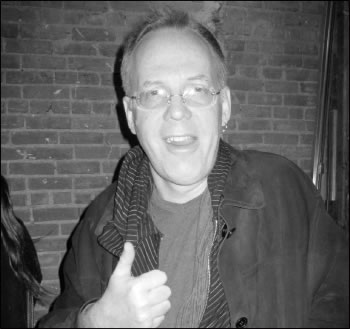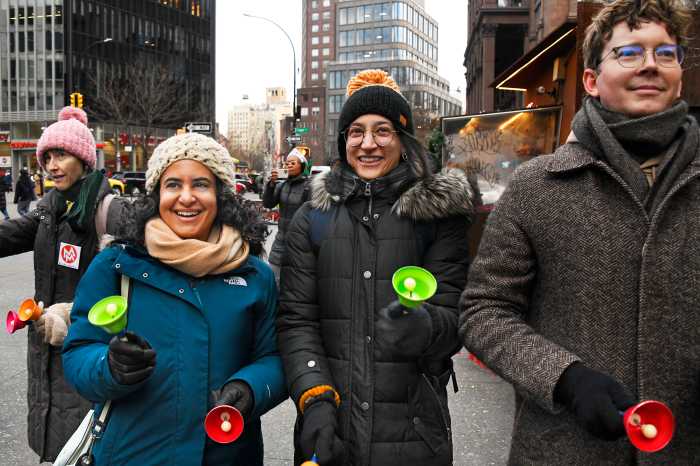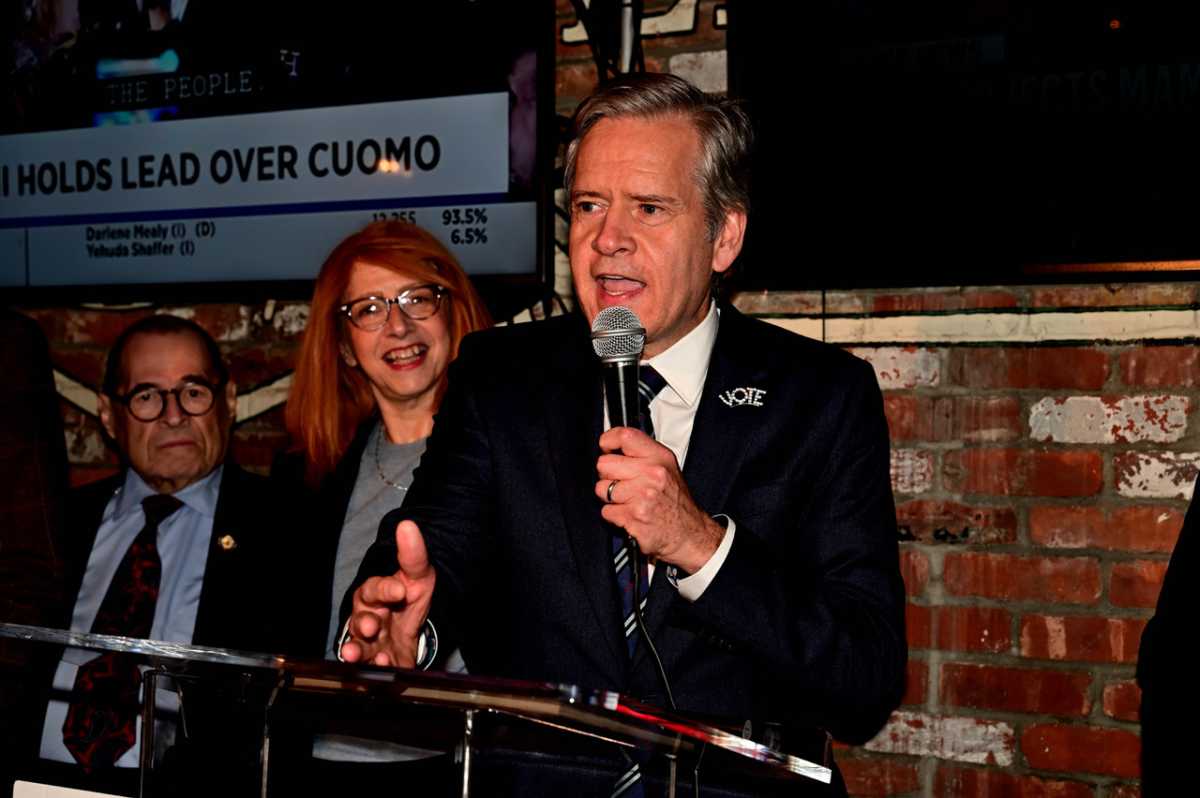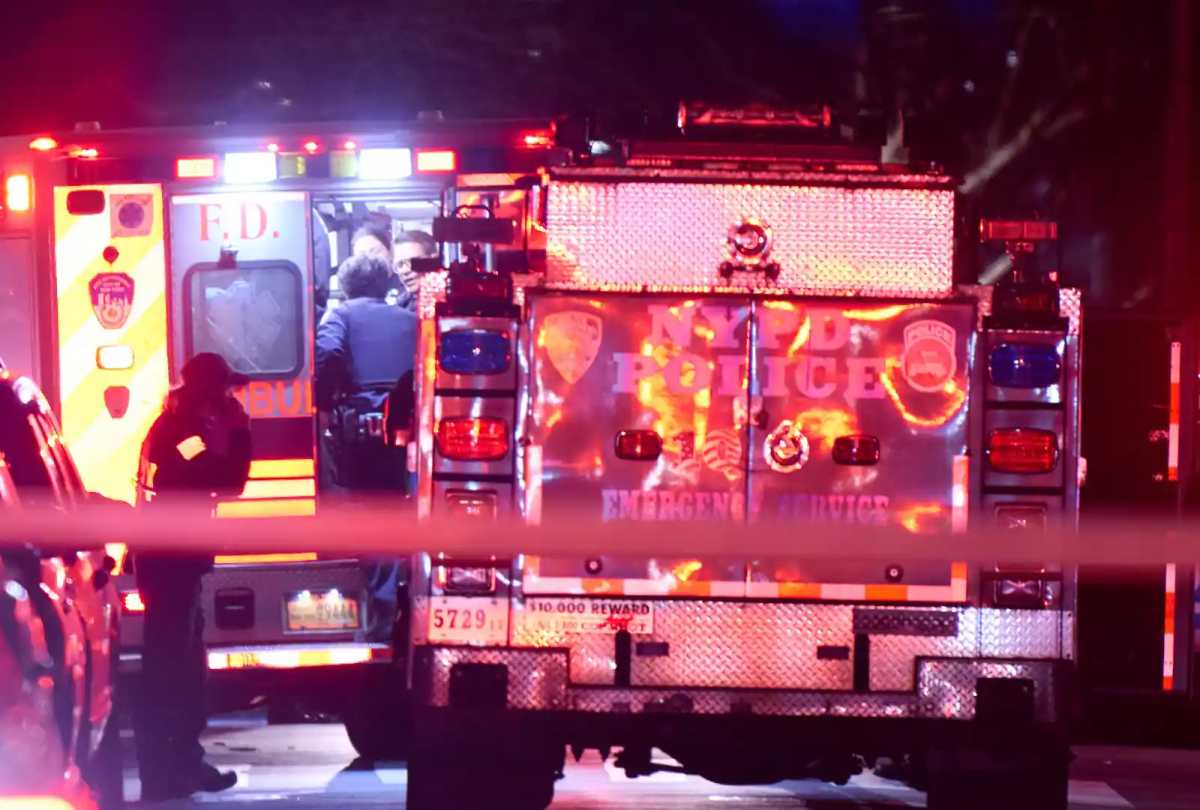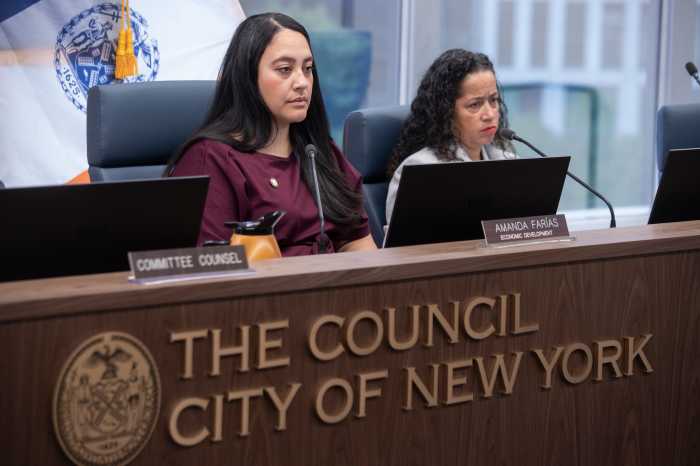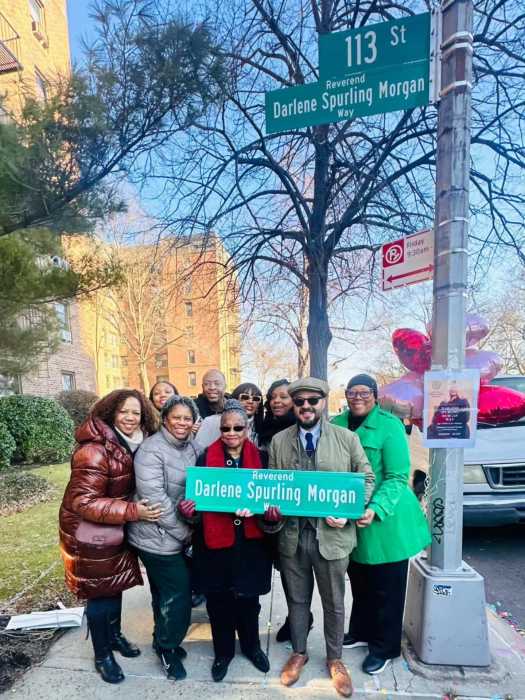By Sarah Ferguson
Here are the images that flashed in my brain the day I learned that squat “godfather” Michael Shenker had died:
Michael in a Santa Claus hat, leaning out the window of a vacant apartment above Life Cafe where he and some homeless guys had staged a one-day squat to protest the warehousing of apartments around Tompkins Square, screaming “Merry Christmas!” to the cops and media, “Housing should be free!”
Michael in a sombrero hat waving at the cameras from one of the broken-out windows in the old glass factory on Avenue D, as a cavalcade of cops and fire engines bore down on the building, exhorting, “It’s beautiful up here, I can feel revolution in the air!”
Or was that what he was yelling from the fire escape of his former squat on E. Eighth St. back in 1989, during that infamous protest when buckets of piss were poured on the cops and city workers to stave off the building’s demolition?
Or when he was holed up in that ABC Community Center on E. Fourth St. and Judith Malina of the Living Theatre and Joseph Papp of the Public Theater crossed police lines to deliver sandwiches that Shenker hauled up in a bucket?
The details of each episode have blurred, but the image of Michael — exhilarated, giddy even, in his defiance — is the same.
As I’ve wandered the East Village the last few weeks, attending one Shenker memorial after another, these images keep coming — quick screenshots of a man who lived a life of protest and struggle — Michael shouting and screaming but always quick to smile, crack a joke, seeking humor in even the most desperate situations.
I don’t mourn him as a close friend but as a trickster presence I always thought would be here on the Lower East Side. Because, as a writer, I grew up alongside Michael Shenker. I was 22 when I began covering the rabble of disaffected squatters, artists, politicos and homeless folks who had carved out what felt like a Left Bank autonomous zone in the heart of Manhattan. Writing in the late 1980’s — first for a small alternative weekly called Downtown and then for the Village Voice — I spent countless hours following Shenker as one of the instigators of this dissentious movement, diligently transcribing his idealistic schemes, then struggling to reconcile them for a more skeptical readership in print.
“Come on, Sarah, you know what this is about,” he would sometimes chide, chafing at my efforts to get him to put into words why he was protesting. He knew a partisan when he saw one. He saved his true eloquence for the dailies.
Back then, folks really did view the L.E.S. as a center of urban resistance. Shenker was no ideologue, but he readily understood that seizing property was a vehicle to empower people, and fought for the squats with a near lunatic tenacity. I vividly recall the hours I spent holed up in the dark with him and several other squatters in his apartment on E. Seventh St., watching the demolition of 319 E. Eighth from his back window. By midnight the block looked like the Gaza Strip, with huge clouds of dust and the gaping maw of No. 319 and the other half-demolished buildings lit up by the cops’ klieg lights, and scores of riot police patrolling the show. Still Michael, dressed in a tuxedo vest, was plotting a last-ditch charge to get back into the building.
A rebellious kid
Where did Shenker’s passion come from? I can’t fully answer that. I know he came to the L.E.S. in the early 1970’s at age 15, fleeing his childhood home in Great Neck, Long Island, though he never explained what made him leave. He said he was a rebellious kid looking to become a musician, enthralled with the crazy scene going down at places like the Fillmore East, CBGB and Max’s Kansas City. He hung out with the Yippies during the big anti-Vietnam War demos in D.C., lived on the streets for a time, cleaned urinals at McSorley’s, even, I’m told, turned some tricks on the West Side when things got rough.
Apartments were cheap back then, so it was easy to get by doing odd jobs. (At one point he lived in an apartment on E. Fourth St. above Madonna.) A true libertine, he picked up a taste for dope, which no doubt led to his contracting hepatitis C — though he kicked his habit by the mid-1990’s and remained an avid 12-stepper until his death.
His passion for squatting seems to have evolved from necessity, coupled with a kind of pit-bull conviction about the righteousness of his cause. In 1984, a fire destroyed much of the building where he was living off Avenue B, and the rent had tripled to the point that he’d stopped paying, so the landlord wanted him out. Around the same time, a friend named Natasha turned him on to the wave of squatting happening in Europe and elsewhere. So they broke into a boarded-up building at 319 E. Eighth St.
By then, others were homesteading in the neighborhood, and the area was so bombed-out that fixing your own place instead of paying rent to a slumlord must have seemed like a natural. The difference, of course, is that Shenker homesteaded without official sanction.
His conviction hardened as real-estate prices surged in the neighborhood and the city and private developers sought to recoup properties left fallow for so long. The first big battle was over Tya Scott’s squat on E. Eighth St., which the city tore down after a bulldozer nicked the facade while clearing the lot next door. I remember Shenker and a group of others using an old wooden joist like a battering ram and running at a line of cops to bust down the door like a pack of crazed Vikings.
Battle of Eighth St.
Then there was the epic showdown at 319 E. Eighth St., which came under threat after it was damaged by a fire in the spring of 1989. By then, Shenker had already moved to another squat on E. Seventh St. But he helped orchestrate a fight to save No. 319 that shut down the block for a week as supporters frantically sought a court order to block the demolition.
I can’t recall if Shenker was on the roof when his housemate Willie Butler shimmied up the fire escape and dumped buckets of fermented piss on the cops and city workers who were setting up scaffolding in preparation to tear the building down. Or if he was downstairs as squat preacher Frank Morales and several others lassoed the scaffolding and yanked it down amid the chaos of the cops and workers fleeing all that piss. But it was such a deftly orchestrated David and Goliath maneuver, I had to cheer (even as I felt for the workers splattered in pee).
This was after the 1988 Tompkins Square Park riot, and after the “Eviction Watch” phone tree had evolved to the point where if a building was under threat, the squatters could get a couple dozen supporters to hit the streets within an hour.
I remember eavesdropping as Shenker and others fought over tactics in closed-door meetings. Or hearing him soapbox atop a milk crate on the corner of Seventh and A. For a movement that always claimed to be without leaders, artist Seth Tobocman credits him in his graphic novel “War in the Neighborhood” as a “maestro” of street actions.
He was a key player in the struggles to defend the burgeoning homeless encampment in Tompkins Square and sought to integrate homeless activists in the squat buildings. His aim was to pose squatting as an answer to the homeless crisis in New York City, then a hot-button issue; and also because Shenker and others viewed the battles over the park as a “wedge” to drive down real estate values in the neighborhood while taking heat off the squats themselves.
It’s a debatable point. Yes, the battles in and around the park kept the cops busy. But they also tarred the squat community as a bunch of rabble-rousing troublemakers, giving the city more justification to boot them out.
The ABC occupation
There were times when Shenker’s crusades seemed to me utterly quixotic. In the fall of 1989 as the police sweeps of the park were in full swing, Shenker helped lead an effort to squat an abandoned school on E. Fourth St., dubbed the ABC Community Center. Several of the park’s “Tent City” homeless activists had returned from a protest march to Washington and were itching to take a building. Shenker readily joined in the takeover, the riotous eviction battle and subsequent reoccupation — camping out at ABC for several weeks through the dead of winter.
Although it won initial support from folks like Malina and Joseph Papp, the ABC occupation was never more than a symbolic fight. The building, already slated for housing for seniors, was a cavernous wreck that as winter wore on, felt like a giant icebox — colder inside than out. Most of the homeless bailed when they figured out they were warmer in the park, leaving competing factions of activists to fight over the place.
To me it felt like a mediagenic gambit from a movement stuck on repeat, looking to recapture the glory that activists had felt in the wake of the Tompkins Square riot — instead of doing the harder day-to-day work of renovating and securing one’s own building.
There’s no question Shenker riled the Lower East Side’s old-guard housing activists, who resented young squatters taking over buildings that their organizations had dibs on. Shenker readily dismissed their complaints: “There isn’t a square inch of sidewalk in this city that some dog hasn’t pissed on,” he once said. He had little respect for the local community board, which had refused to back his early homesteading efforts on E. Eighth St. I recall one Community Board 3 meeting in the wake of the 1988 park riot when Shenker and others rolled old tires into the lobby — a reference to the gruesome practice of “necklacing” traitors in the fight against apartheid.
Not the kind of tactic to win friends in high places.
Struggles added up
Yet, in the end, Shenker insisted, the fierce battles fought over the park, ABC and the other squats cost so much that it made the police and City Hall think twice about evicting more-established buildings — leading to the eventual deal to legalize the area’s remaining squats as low-income co-ops.
“We never went down easy,” Shenker told me when the preservation plan for those 11 squats was announced in 2002. “Nothing was wasted, because we learned from our mistakes, and because the city realized they couldn’t just take us out without a big political fight.”
Of course, Michael did spend an awful lot of time renovating 209 E. Seventh St. — and helping power up many other squat buildings, too. I remember interviewing him at No. 209 back in 1989, where he lived with a piano, a futon and his power tools. In a room downstairs, he had taken in the old Nuyorican street poet El Coco Que Habla — the “Talking Coconut.” Coco made collages of poems on strips of paper — so his room was several feet deep in shredded newspaper and cardboard.
“He’s kind of like a gerbil,” Michael shrugged with a smile.
After a fire gutted much of the squat in 1990, Shenker was one of the few who remained to rebuild it, at one point breaking his back falling through two floors. I recall finding him there in 1991, virtually alone in this hulking shell of a building with no heat or water — so bereft that it was used as a set for the filming of that Matt Dillon movie about the homeless, “The Saint of Fort Washington.”
A self-taught plumber and electrician, Shenker was infamous for his ability to hotwire a building by going down the manhole and reconnecting the current from the street. It was his classic touch to leave a bottle of scotch in the hole for the Con Ed workers who would be dispatched to disconnect the power once the city caught on.
“Michael knew those blue collars would be savvy enough to understand the gesture,” said former squatter and electrician Art Cabrera. “If the Con Ed workers were mean, they would cut the wires inside the pipe, and it would be a bitch to reconnect,” Cabrera explained. “But if they were merciful, they would leave enough wire that it would be easy.”
But eventually the Con Ed workers grew tired of having to disconnect Shenker’s handiwork. Comic book artist and fellow squatter Fly remembers watching Shenker tear through wet cement that Con Ed workers stuffed inside the conduit pipe outside 209 E. Seventh St. They even left a note: “Dear Michael, if you go down this manhole one more time, we will lock you up.”
“I told him he should frame it,” laughed Fly. Needless to say, Shenker got the power back on.
Shenker also schooled other squatters in how to wire their places safely.
“See Skwat would have probably burned down if it wasn’t for Shenker. He helped us so many times,” said Peasant Shane, who lives at the now-legal punk homestead at 155 Avenue C.
And he continued helping out young squatters even after he was diagnosed with stage 4 liver cancer in May.
“Just two or three months ago, I saw him in Brooklyn coming out of a crawl space black with soot because he was wiring up the building,” said his friend Jim Simopoulos. “He kept doing it until the end. And just a few weeks ago, he was here playing piano on the corner of E. Fifth St. Even though he was in a lot of pain, he just kept doing it.”
Defending the green
Shenker saw an implicit connection with squatting and the fight to save community gardens, most of which began on squatted land. In 1998, he helped found the activist group More Gardens! after the Giuliani administration announced plans to sell off more than 400 green spaces citywide. In the process, he helped embolden the gardens fight with his go-for-broke tactics and street theater.
“He helped inspire us to fight,” said Brent Sharman of the former Esperanza Garden on E. Seventh St. For nine months, Shenker and the other More Gardens! activists and supporters camped out and fortified the garden with an array of eclectic structures, including a giant wooden “coqui” frog where they slept. When the bulldozers came, Shenker locked down using a “sleeping dragon” — a metal tube cemented into the earth. “They had to jackhammer and then carry him out,” recalled More Gardens! co-founder Aresh Javadi.
Michael sought to bring similar direct-action energy to the antiwar movement — with less success. He had little patience with the big antiwar coalitions like United for Peace and Justice, which he saw as too timid and predictable. He helped found the group No Blood for Oil! and was arrested numerous times both outside and inside the United Nations — friends say he once managed to infiltrate the Security Council chambers. Perhaps that was what earned him a spot on the N.Y.P.D.’s list of “most dangerous” anarchists in the lead-up to the 2004 Republican National Convention — an absurd tag to those who knew him.
No saint, but a slayer
How to reconcile the generous, anything-goes Michael with the guy who in recent years became so incensed by the sound of his upstairs neighbor Dan Yafet’s children playing above him that he harassed Yafet at work and even had a friend call Yafet’s parents in New Jersey to complain?
Many of Shenker’s closest friends split with him over the issue of how much ex-squatters should be able to profit from their buildings once they were converted to low-income co-ops. Shenker fought vociferously against the resale restrictions that the Department of Housing Preservation and Development and the nonprofit sponsor group UHAB (Urban Homesteading Assistance Board) were attempting to impose. After so many years hearing him declare “housing should be free,” it seemed incongruous that Shenker felt he should be able to sell his former squat apartment for something close to market rate.
Admittedly, the initial sale restrictions of $5,000 per “zoning room” were quite severe — far less than what most squatters had invested in their units, let alone what other H.D.F.C. buildings are allowed. But Shenker still bristled at the eventual compromise restrictions of roughly $30,000 per zoning room.
Friends say Shenker’s brush with death after being struck by an S.U.V. in 2005 had a big impact on his thinking. He suffered serious head injuries and spent several months recuperating in the hospital.
“For a while, he was worried he might not be able to function on his own,” recalled Morales.
“I think, rationally, he tried to justify it as, Why shouldn’t squatters have the same rights that everyone else does?” Morales said of Shenker’s stance on his right to profit from his apartment. “But I think, emotionally, he was coming from someplace that he would have to take care of himself down the line and might need to sell his place to relocate somewhere else.”
Once a squatter…
Yoga instructor and longtime L.E.S. resident Steve Prestianni, a.k.a. Paz, who also lives at No. 209, said he aligned with Shenker’s view: “It was a little about the money. He felt like he was getting old and might need to be taken care of at some point. But it was more like, Who are they to tell me what I am allowed to sell or not sell for? I mean, what squatter ever readily accepted being regulated?”
I could sense Seth Tobocman struggling to reconcile Shenker’s position in the eulogy he delivered at El Paradiso on E. Fifth St., one of the many community gardens Shenker’s activism helped save.
Tobocman, who organized for many years with Shenker, compared his fallen comrade to a dragon slayer.
“What kind of person kills a dragon?” Tobocman asked, speaking from a bullhorn to the 200 people milling on the grass. “Is a dragon killer a saint who does this out of love for all humanity, seeking no compensation for himself? I don’t think so. To kill a dragon you have to be a bit of a dragon yourself. You don’t kill a dragon out of the kindness of your heart.
“Maybe a man kills a dragon because he wants an apartment of his own, which he builds with his own hands, which no one can take away from him,” Tobocman suggested. “Where he can cook his meals and entertain his friends. Where he can play his piano and sing songs that other people might think are corny. Maybe he attains these things for himself, and in so doing, attains them for his whole community. And maybe he’s enlightened enough to realize he can’t do this alone.
“So Michael Shenker killed the dragon and saved the village and won the castle,” Tobocman concluded. “Not all of us agreed with his political decisions. But Mike never let anybody make his decisions for him. Mike was a free man, and that’s about the best you can get.”
It was a roundabout way of acknowledging that there may have been much self-interest driving Shenker’s crusade for the squats and the park and the gardens. But then what successful social movements don’t have self-interest at heart?
At his best, Shenker transcended selfish motives and fought for a community he loved and the principles he believed in. Yes, he lost many battles, but he also accomplished more than any of us would have expected.
One last march
So it felt like a familiar ritual when more than 100 people gathered in the center of Tompkins Square on Sat., Oct. 16, then set off on a funeral march around the neighborhood, accompanied by an anarchist brass band playing New Orleans-style spirituals. Except this time, many of the squatters in the crowd were pushing baby strollers instead of barricades. And unlike the old days, the cops showed little interest in policing the crowd, even when the marchers invaded the site of a former community garden on Avenue C that was bulldozed for condos. A security guard shrieked as the marchers clawed up a patch of weedy earth and planted a “spiral” of Allium bulbs in Shenker’s honor.
After stops on Eighth and Seventh Sts., the march concluded on E. Third St. at Maryhouse, the soup kitchen and theater run by the Catholic Worker.
People sang folk songs and listened to old tapes of Shenker banging out rhythm and blues on the piano — reminding me of the early days of squatting, before all the bars saturated the nabe, when folks here used to entertain themselves.
Though I knew Shenker was involved with the Living Theatre, it was surprising to learn that he was a musical director for the troupe from 1989 to 1993 — during some of the most contested years of the squatting movement. But it makes sense, his frenetic merging of art and activism.
This past Sunday, friends hosted a benefit at the Sixth Street Community Center to raise funds for Shenker’s final expenses. There were performances by close friends like Eric Drooker and Stephan Said — and a balletic “interpretation” of a scene from Shenker’s “Squatter Opera.” Shenker staged the opera in 1994 at the Theater for the New City, but was apparently too busy living his art to complete it.



